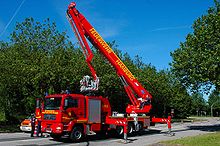Aerial rescue vehicle




Aerial rescue vehicles are fire brigade vehicles that are equipped with a mechanically operated aerial rescue set.
Aerial rescue vehicles are mainly used to rescue people from great heights. These vehicles are also used for fire fighting and technical assistance . The safety requirements for Germany are based on DIN EN 1777 : aerial rescue vehicles for fire and rescue services, aerial work platforms.
The aerial rescue vehicle predominant in Germany today is the fire brigade's turntable ladder (DL, DLK) , in particular the standardized DLK 23-12 , which with its rescue cage reaches a nominal rescue height of 23 meters with a nominal radius of 12 meters. Buildings that are more than 22 meters high (floor height of a lounge above floor level) are considered high-rise buildings in Germany and must be structurally via two escape routes such as B. have safety stairwell and outside staircase.
The telescopic mast (TM) with a working platform is an alternative to the turntable ladder . As this usually has more degrees of freedom than the turntable ladder, it can be used to move to positions that cannot be reached with turntable ladders. The disadvantages of this advantage are the longer set-up times and, in most models, the lack of a continuous ladder to quickly rescue a large number of people.
Other systems in aerial rescue vehicles are articulated masts and ladder platforms.
Modern aerial rescue vehicles usually have a crew . Fire-fighting equipment usually includes a particularly long, coupling-free pressure hose that does not get caught in the ladder rungs, and often a device for attaching a reversible pipe . In addition, a jump rescuer is often carried along.
Due to the complex technology, aerial rescue vehicles are particularly expensive fire fighting vehicles. In order to avoid such an investment, municipalities limit, for example, more than three-story development without a second structural escape route.
See also
literature
- Jan Ole Unger, Nils Beneke, Klaus Thrien: Aerial rescue vehicles - training and use . 3rd, revised edition. Kohlhammer, Stuttgart 2019, ISBN 978-3-17-035837-9 , pp. 221 .
- Lothar Schott, Manfred Ritter: Fire Brigade Basic Course FwDV 2 . 20th edition. Wenzel-Verlag, Marburg 2018, ISBN 978-3-88293-220-1 .
Web links
Individual evidence
- ↑ P. 212 von Fleck, Adolf in Prendke, Wolf-Dieter: Lexikon der Feuerwehr, 3rd edition 2005, Kohlhammer Verlag, ISBN 3-17-018610-8
- ↑ The exact regulations for this can be found in the state building regulations (LBO) of the federal states (e.g. § 29 Brandenburg building regulations).
- ^ Rainer Fritz Lick , Heinrich Schläfer: Accident rescue. Medicine and technology . Schattauer, Stuttgart / New York 1973, ISBN 978-3-7945-0326-1 ; 2nd, revised and expanded edition, ibid 1985, ISBN 3-7945-0626-X , p. 92.